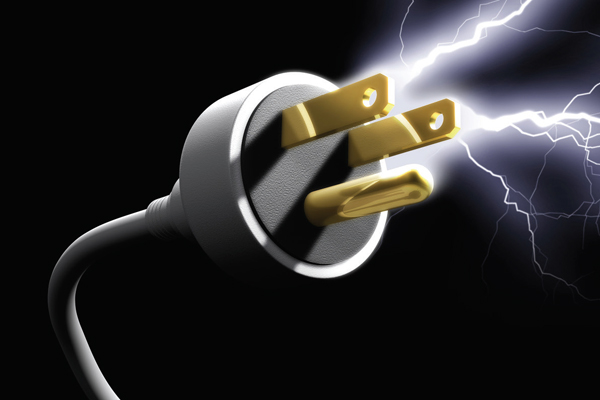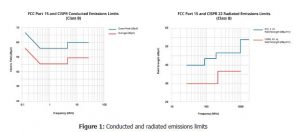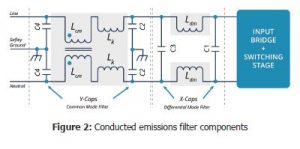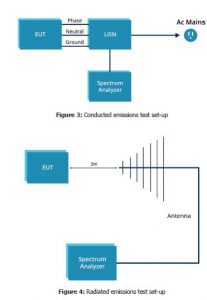One of the design activities often left to the end of a project is verifying that the product meets electro-magnetic compatibility (EMC) emissions requirements. EMC regulations help to ensure unintentional electro-magnetic conducted and radiated emissions do not interfere with other electronic devices. While delaying EMC compliance testing until the end of the project is a common practice, unexpected costs and project delays can be avoided by considering EMC compliance earlier in the design process.
Electro-magnetic conducted and radiated emissions are the radio frequency (RF) energy emitted by a product. The level of RF emissions are regulated to ensure they do not cause unreasonable harm to other electronic products. At low frequencies (less than about 30 MHz) the conductors and cables of most electronic devices are ineffective as antennas and thus radiated emissions are not an issue. At these low frequencies the conductors and cables can conduct RF energy through shared power sources or loads and cause issues with other electronic products, while at high frequencies (above about 30 MHz) the impedances of the conductors and cables attenuate the conducted energy sufficiently to prevent it from being an issue. However, at these higher frequencies the conductors and cables can serve as antennas and radiate the RF energy with the ability to cause interference with nearby electronic products.
Most industrial and consumer electronic products sold in the United States are required to meet conducted and radiated emissions standards as described in FCC regulations Title 47 Part 15, often referred to as FCC Part 15. Similar standards for products sold in Europe are governed by European regulations CISPR 22/EN 55022. Both sets of these regulations describe limits for conducted and radiated emissions and are applied to the final system, including the internal or external power supply. While these two sets of regulations are created and administered by separate organizations they have been constructed to be similar or “harmonized”. One benefit of harmonizing these regulations is that designing a product to meet one set of regulations typically ensures it will also satisfy the requirements set forth in the other set of regulations. Conducted radiation specifications cover emissions in the frequency range of 150 kHz through 30 MHz. A separate set of radiated emissions specifications covers the spectrum of 30 MHz and greater. Test procedures and tools are slightly different for conducted versus radiated emissions and the filter components used to mitigate the EMC issues are similar but differ in electrical values. The conducted emissions frequency band is lower than the radiated emissions frequency band and thus the filter components used to address conducted emissions will be electrically and physically larger than those required to address radiated emissions.
EMC for Power Supplies
Most internally mounted power supplies are designed and tested to meet EMC regulations and the testing is performed with the supply configured as a stand-alone product. After the power supply has been installed into a system the completed system must also be tested to ensure it meets EMC regulations. Incorporating compliant power supplies into systems minimizes the potential for EMC related issues during system testing, but does not guarantee that the completed system will pass emissions testing. Many vendors of internally mounted power supplies will provide recommended circuits to address EMC issues encountered during system integration. Because the requirements vary with each application, these recommendations are left to the discretion of the designer; this way each design incorporates only the components required for the specific application.
Similarly, most wall plug and desktop versions of external power supplies are also designed and tested to meet EMC regulations as stand-alone units. If the power supply customer is a manufacturer combining the power supply with a load then they will be required to perform testing to ensure the complete system meets EMC regulations. As the circuitry is housed in an enclosed case, adding external components to address EMC issues will be more challenging for wall plug and desktop versions as compared to internally mounted power supplies.
EMC regulatory testing of power supplies is performed with static resistive loads, but almost all power supplies are based upon switching regulator topologies. A switching regulator inherently produces conducted and radiated emissions which need to be mitigated in the design of the supply. The load applied to the power supply may create additional emissions. The uncertainty of the conducted and radiated emissions from the combined power supply and load is addressed by allowing a margin in the stand-alone power supply test results to take into account variations when a load is applied to the power supply.
The Case for Early Testing
Often EMC testing is put off until the end of a project due to time, cost and workload constraints. Unfamiliarity with compliance testing also contributes to the perception of the difficulty of such testing. While the required equipment and facilities for EMC compliance testing can be unique, many testing labs are available with experienced staff to assist in the testing.
The costs associated with compliance testing often become a ‘pay me now or pay me more later’ event. As testing is usually done at the end for full certification this cost can be high, but for preliminary screening the cost is minimal. Availability of lab time can be an issue as many labs are booked up several weeks out. However, small blocks of time for preliminary testing typically can be found outside of peak hours. The small amount of resources spent performing preliminary EMC testing early in the design cycle may prevent considerable and expensive redesign efforts late in the product schedule.
Another common reason for delaying the EMC testing of a system is the misconception that the power supply causes the EMC issues and thus a system will pass testing if the supply has already passed stand-alone regulatory testing. In many instances, the power supply is the recipient of the blame for EMC issues within the system when in reality it is ‘only the messenger’.
While system conducted and radiated EMC issues are often addressed at the end of a project, that phase in the schedule is perhaps the worst time to introduce unexpected tasks and delays. A more reasonable and often lower cost strategy is to perform preliminary EMC compliance testing as soon as the system assembly has begun. Earlier in a project, schedules are more flexible and design teams are more receptive to modifications in the design.
By the end of a project much effort has been applied to designing the system to meet performance criteria and if an EMC compliance issue arises the power supply is perceived as the easiest target for compliance efforts without affecting other system performance parameters. Although the system is often the source of RF emissions, the cabling on the input and the output of the power supply may be serving as antennas for radiated emissions and conductors for conducted emissions. It is often possible to add noise suppression components to the power supply to address the EMC issues, but this activity should be recognized as mitigating the effects of the problem and not addressing the source of the problem. The EMC suppression activities associated with the power supply require time from the design team and may affect the safety certificates associated with the power supply. Any changes to the safety certificates will also require time and resources from the power supply vendor. The system circuitry may need to be modified to minimize the generation of RF signals if adding conducted and radiated emission suppression components are insufficient to adequately reduce the EMC problems.
For products which use internal power supplies, EMC noise suppression components can be added either on the conductors feeding into the power supply or on the cabling between the output of the power supply and the power input to the system. Bypass capacitors and ferrite cores are suppression components used to create filters to address EMC issues. Ferrite cores introduce additional inductive impedance in series with the path of the unintended noise and bypass capacitors provide a low impedance path to shunt noise signals to minimize signal propagation.
Systems employing external power supplies may be more limited in their ability to add EMC suppression components on the input or output paths of the power supply. Radiated emissions issues are typically addressed with a ferrite core placed on the cable between the power supply and the system. The frequencies of concern associated with conducted emissions are low enough such that the size of a ferrite core required to fit around a power cord and mitigate EMC issues will be unacceptable for many applications. Conducted emission issues observed in systems with external power supplies are often most easily addressed by working with the power supply vendor to modify the design of the existing supply or selecting a different external power supply incorporating enhanced conducted emissions suppression components.
Pre-Compliance Testing
Final testing of conducted and radiated emissions needs to be performed in a certified laboratory using calibrated test equipment and a controlled electrical environment. Testing labs will cooperate to perform pre-compliance testing early in the design phase. If the design team desires to conduct the pre-compliance testing themselves the tests can be performed in a room with a minimal amount of test equipment. The equipment required for conducted emissions testing is an LISN (Line Impedance Stabilization Network) and a spectrum analyzer. The LISN is a passive network used to minimize the noise conducted from commercial power lines and also provides a controlled impedance test port to monitor the conducted emissions from the EUT (Equipment Under Test). The spectrum analyzer used for conducted emissions testing can be a basic model with the ability to perform measurements from 150 kHz through 30 MHz. Many vendors of spectrum analyzers include the ability to perform quasi-peak measurements and incorporate conformance parameter limits in the display to simplify EMC compliance testing.
Preliminary testing for radiated emissions can be accomplished with a spectrum analyzer and an appropriate antenna. The spectrum analyzer should have the capability to make measurements from 30 MHz through at least 900 MHz. The ability of the spectrum analyzer to perform quasi-peak measurements and display conformance parameter limits in the display will make the preliminary testing tasks easier to perform. The antenna used for preliminary radiated emissions testing should have a bandwidth similar to the spectrum analyzer and the gain versus frequency characteristics needing to be known. It is preferable to be able to perform the radiated emissions testing in an electrically quiet room with at least three meters (10 feet) between the radiated emissions EMC antenna and the EUT. An initial measurement in the room with the EUT powered off will provide information regarding the ambient RF noise present during the testing.
Most management teams appreciate projects completed under budget and ahead of schedule. Unfortunately, EMC compliance issues can be a common source of last minute budget and schedule increases for projects. Performing pre-compliance EMC testing during the system assembly phases of a project can help to eliminate those last minute changes to a design that impact budgets and schedules. Pre-compliance EMC testing also helps to ensure no issues arise during final compliance testing. Full service power supply vendors, such as CUI, have the equipment and experience to assist in power supply design and selection, including pre-compliance and final EMC testing.










